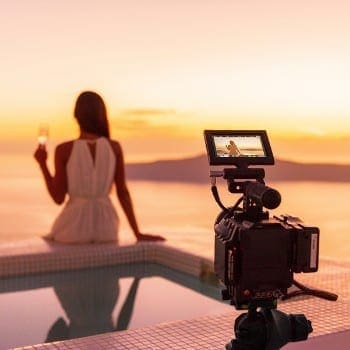 When making hotel bookings online, potential guests’ expectations of service quality are influenced by the aesthetics of the hotel’s website, according to Dr Ksenia Kirillova and Ms Janelle Chan of the School of Hotel and Tourism Management (SHTM) at The Hong Kong Polytechnic University. In a recent experimental study the researchers manipulated the level of attractiveness portrayed by a hotel website’s photos to examine how aesthetics influenced perceptions of quality and intention to book. Their results provide important insights into how hotel managers can use visually attractive images to stimulate positive perceptions of quality and thus increase bookings.
When making hotel bookings online, potential guests’ expectations of service quality are influenced by the aesthetics of the hotel’s website, according to Dr Ksenia Kirillova and Ms Janelle Chan of the School of Hotel and Tourism Management (SHTM) at The Hong Kong Polytechnic University. In a recent experimental study the researchers manipulated the level of attractiveness portrayed by a hotel website’s photos to examine how aesthetics influenced perceptions of quality and intention to book. Their results provide important insights into how hotel managers can use visually attractive images to stimulate positive perceptions of quality and thus increase bookings.
Appearances are important in all sorts of contexts, as highlighted by the expression “what is beautiful is good”. This, the researchers explain, is demonstrated by the halo effect, whereby physically attractive people are rated as having more positive and desirable qualities and traits.
The halo effect has also been shown to apply to products and services. A consumer’s first impression of a product is generally based on its visual appearance. This first impression elicits an emotional reaction that “initiates the process of connection between consumer and product”, according to the researchers. Perceptions of a product based on its aesthetic appeal can thus influence the product’s commercial success.
Aesthetics are clearly important in high-design and artistic products but are also influential in perceptions of non-tangible goods and services. The researchers hypothesise that the effect may be particularly strong in an online context, where product quality is largely judged by website quality because the actual product or service cannot be experienced before purchase. As hotel bookings are commonly made online, prospective guests must rely on hotel websites when making their decisions. Thus, the image of the hotel portrayed by the website could influence perceptions of different aspects of quality.
The physical setting in which a transaction occurs and the qualities of a transaction environment are known to influence consumer behaviour, but the researchers note that there has been little attempt to explore these factors in the hospitality sector. Usually, considerations are limited to onsite evaluations of the consumption experience. They thus sought to explore how the aesthetics of hotel websites, such as the quality of photographs, influence perceptions of hotels’ service quality and hence consumers’ booking intentions. Also of concern was the “interplay between aesthetic value and functional value in forming consumer expectations of hotel service quality and determining booking intention”.
The researchers conducted an online experiment in which participants were told to imagine they were “planning a short beach vacation and searching for a suitable four-star hotel online”. Four randomly assigned groups were then presented with different photographs of a hotel façade, lobby area, front desk, dining area, swimming pool and a room, depicting either a high or low aesthetic value. They were also shown a list of hotel attributes representing either extensive or limited hotel amenities.
After being exposed to the information, the participants responded to questions about their perceptions of the hotel’s expected service quality, as measured by tangible features – such as facilities, equipment and staff appearance – reliability, responsiveness, assurance and empathy. The participants’ booking intentions and their tendency to appreciate visual aesthetics were also measured.
The 203 participants were all residents of mainland China and had stayed in a 4 or 4.5 star hotel in the past year. Their average age was 38, there were slightly more males than females, and their level of education was high, with a majority having at least a Bachelor’s degree.
Perhaps not surprisingly, when the hotel projected a high aesthetic value, the participants rated it as having superior physical facilities. The researchers admit that this is predictable given the visual nature of aesthetic judgement, but they point out that their findings show the importance of this effect before the service encounter has even taken place.
Perceptions of expected hotel service quality and credibility were also influenced by the depiction of the hotel’s aesthetics. The researchers observe that if potential guests regard a visually appealing hotel as more reliable and dependable, then “aesthetic cues carry insights into a hotel’s professionalism and thoroughness as a business operation”. This is particularly important in an online purchasing context, where website aesthetics represent a critical decision-making criterion.
These findings obviously have important implications for hotel managers. For instance, the researchers note that sales and marketing teams could use professional photographers and artists to take beautiful photographs with appealing compositions. They further advise that such professionals should seek to create compositions that balance “the elements of classic and expressive aesthetics”. The components of classic aesthetics include image, order, legibility, symmetry and clearness, whereas expressive aesthetics encompass more hedonic features such as originality, fascination and colour vibrancy. A product with high aesthetic value should have both high classic and high expressive aesthetic value. However, given the subjective nature of aesthetic value, the researchers advise testing such materials on target audiences to ensure they have the desired effects before posting them on a hotel’s website.
The aesthetic effect did not extend to the participants’ perceptions of the hotel’s responsiveness or empathy, even though such soft skills are often the best predictors of overall service quality. The researchers were rather surprised to find that favourable aesthetic appraisals did not spill over to their evaluations of the more human-related characteristics, as the halo effect would predict. Indeed, they suggest that the major contribution of the study may be the finding that the aesthetic effect is limited to the evaluation of product usability and function.
To overcome this limitation, when producing marketing photographs and videos, the researchers advise that hotels could consider employing “attractive individuals to pose as hotel staff” and show them interacting with customers to communicate their “warmth, empathy and care”. The human touch could be emphasised by photographs showing hotel employees interacting with guests with particular needs, such as older people and children.
The attractiveness of the hotel, the researchers note, seemed to “deflect attention” from the hotel’s amenities. In other words, prospective guests’ service quality judgements and booking intentions were unaffected by differences in the description of the available amenities in the presence of the aesthetic effect. Hence, hotels could provide attractive photographs of amenities rather than just listing them, as this will provide a more holistic perception of the hotel’s aesthetic and functional features.
However, it is worth mentioning that the participants were not equally swayed by the hotel’s aesthetics. It was, explain the researchers, their “individual tendency to appreciate beauty” that exerted “considerable influence” on their evaluations of the expected service quality and booking intentions. This suggests that despite the strong influence of aesthetics, the effect should not be over-estimated or assumed to apply to all potential guests.
One final tip from the researchers is that many consumers trust user-generated content more than sales and marketing content, so engaging with social media could be a useful channel for enhancing a hotel’s aesthetic effect. Pictorial and video content “enjoys unrivalled popularity” on social media sites such as Instagram, Snapchat and Yupoo. Encouraging guests to share images through such sites could help hotels to reach much wider audiences.
The researchers caution that further consideration is needed in other contexts, such as midrange and budget hotels, and with different types of travellers in mind, such as families and business travellers. They also point out that Chinese consumers “differ from their Western counterparts in terms of aesthetic appreciation patterns”, so the findings might be less applicable to Western tourists. Nevertheless, they provide tourism businesses with valuable insights into how they can boost their image and maximise bookings in the highly competitive online travel market.
About the authors
Ksenia Kirillova and Janelle Chan. (2018). ‘What is Beautiful We Book’: Hotel Visual Appeal and Expected Service Quality. International Journal of Contemporary Hospitality Management,
30(3), 1788-1807.


















